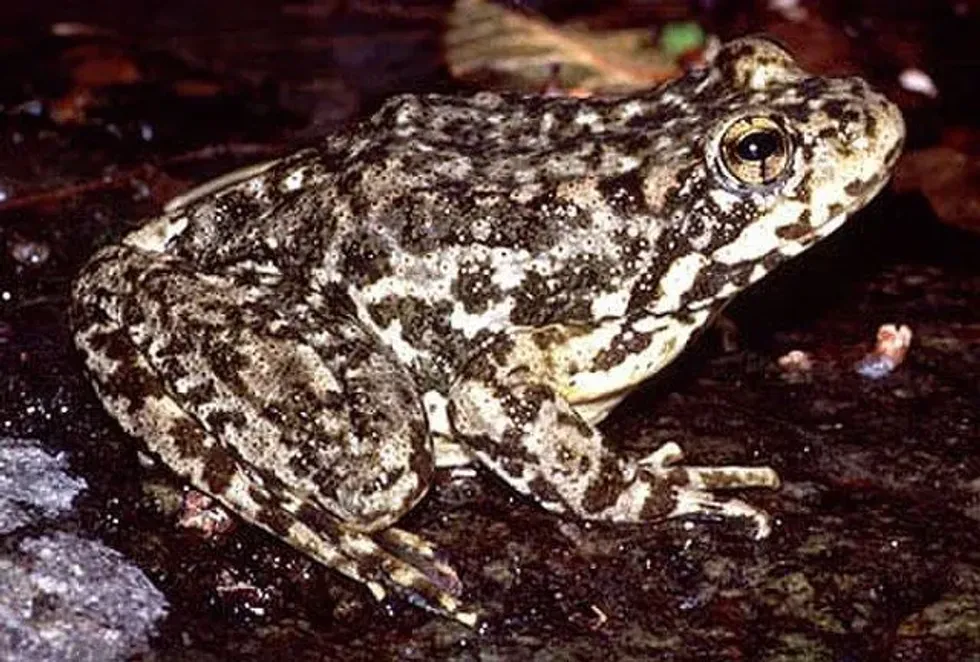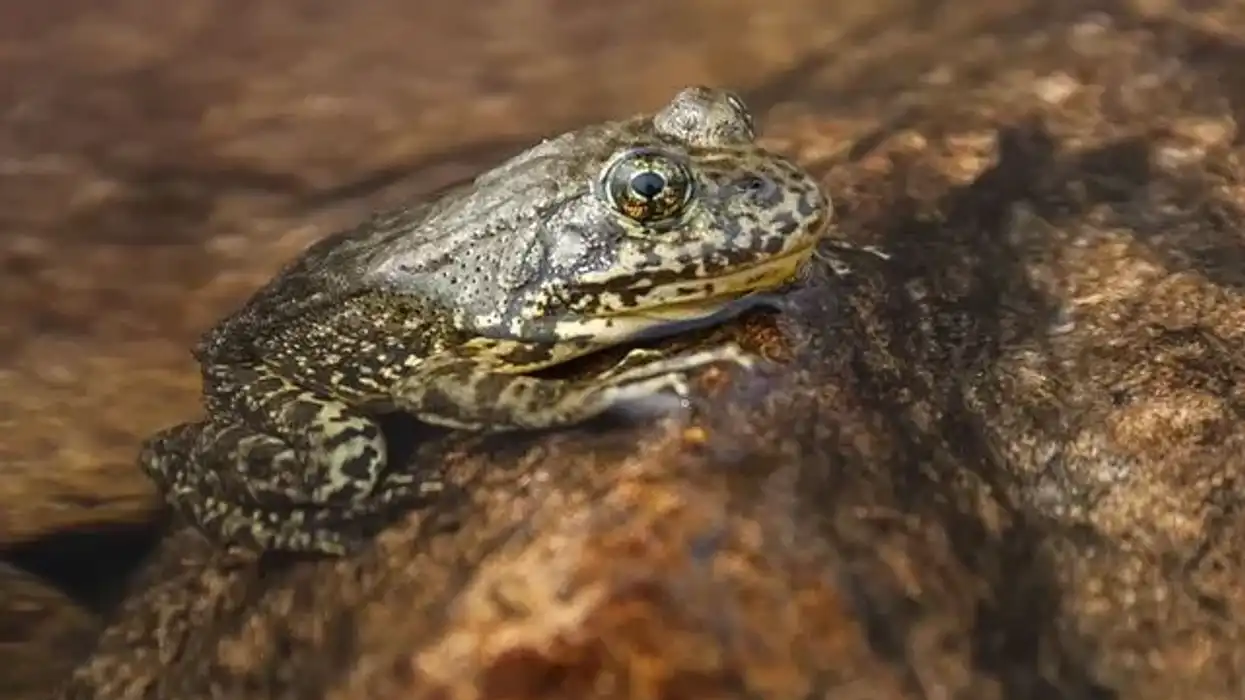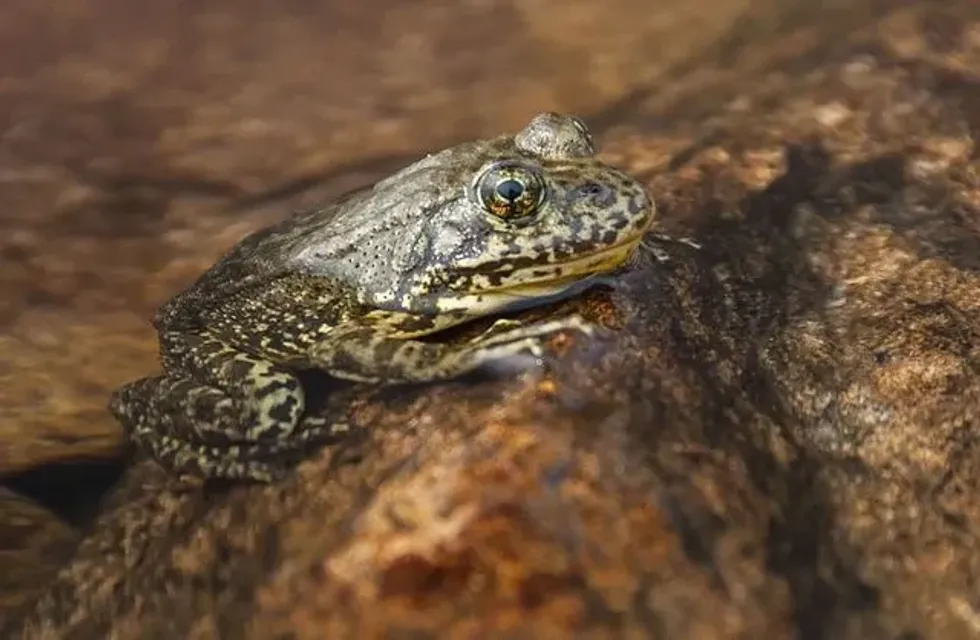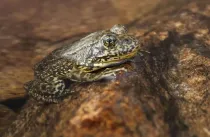Fun Mountain Yellow-legged Frog Facts For Kids

Mountain yellow-legged frogs are a species of frog that are endemic to southern California and are found in small patches throughout the wildlife of Sierra Nevada. These frogs have been divided into two species by where they are found, the populations found in California and the ones found in the northern and central parts of Sierra Nevada.
Both Sierra Nevada yellow-legged frogs and mountain yellow-legged frogs are Endangered due to a large decline in their populations. Due to this steep decline in their populations, these frogs are strictly protected in California and other parts of their habitat region.
They are put under recovery programs and are carefully bred in captivity and are protected before they are put back in the wild. Hopefully, with these recovery programs, the populations of these amusing frogs can get back to what it was before.
If you liked these true facts about mountain yellow-legged frogs, then you'll surely like these facts about the Vietnamese mossy frog and desert rain frog too!
Mountain Yellow-Legged Frog Interesting Facts
What type of animal is a mountain yellow-legged frog?
Mountain yellow-legged frogs (Rana muscosa) are small frogs. These frogs are highly aquatic and are often found in a high elevation ranges which make up large parts of their natural habitats.
What class of animal does a mountain yellow-legged frog belong to?
These frogs (Rana muscosa) belong to the class of amphibians and are cold-blooded, four-limbed vertebrates.
How many mountain yellow-legged frogs are there in the world?
As of studies based on surveys in 2009, the population of mountain yellow-legged frogs is estimated to be around 166 individuals occurring in their natural habitat. The population decline of these frogs has led them to becoming an Endangered species.
This happened because of human interference in the wildlife of southern California and the Sierra Nevada region which has caused major habitat loss. Also, humans introduced trout and other animals to the ecosystem of these frogs which turned out to be predators of these frogs.
These frogs are also threatened by disease, pesticides, and environmental changes that occur in streams, lakes, mountains, and other aquatic habitats.
Where does a mountain yellow-legged frog live?
The mountain yellow-legged frog (Rana muscosa) is mostly found nearby aquatic bodies as this habitat range has a great food source that nourishes these Endangered frogs.
As of now, these frogs occur in a scattered population across southern California and the Sierra Nevada as there are a total of 10 streams in southern California that these frogs can be found in. In the Sierra Nevada forest region, they can be found from Mather Pass to Monarch Divide.
What is a mountain yellow-legged frog's habitat?
In the wild, the mountain yellow-legged frog (Rana muscosa) inhabits permanent streams, ponds, creeks, and pools that are cold and shaded. These frogs are highly aquatic as large breeding populations require a water body around them as metamorphosis can take up to two years in the wild.
Natural free-flowing water with rock, gravels, or logs above the water body around them is used as a resting and basking place with plenty of foliage in the range for protection from predators. The vegetation around these water bodies consists of conifers, willows, and maple trees.
Who do mountain yellow-legged frogs live with?
These frogs are solitary in nature and are mostly a territorial frog species. They live in scattered populations and mostly come together during the breeding season. Females occupy a larger territory compared to males.
Adult frogs obtain their oxygen through their skin and mouth and occupy shallow creeks and ridges under frozen lakes and ponds during the winter. These frogs will bury themselves in the substrate to protect themselves from threats.
How long does a mountain yellow-legged frog live?
The lifespan of these frogs is around 14 years in the wild which covers the entirety of their lifetime, from eggs to mortality. However, in most cases, these animals fall prey to diseases, predators like fish, and sometimes humans.
How do they reproduce?
The mountain yellow-legged frog (Rana muscosa) species becomes sexually mature when they are two years old. The mating season of these frogs lasts from April to July and large breeding populations can be found in the wildlife congregating.
Males make croaking or clicking sounds to attract females and if the female is receptive, she will allow the male to mate with her. After copulation, the female will lay 40-300 eggs on aquatic plants or gravel.
The eggs are laid during late spring to early summer and have a hatching period of 18-20 days. They require a favorable temperature of 55 F (13 C).
What is their conservation status?
Currently, the mountain yellow-legged frog (Rana muscosa) is listed as an Endangered species on the IUCN Red List. This frog species has seen a large-scale decline in its population due to human interaction in its native habitat as this species faces habitat loss due to human interaction with forest wildlife.
Also, the introduction of trout fish in the water bodies around these frogs has also caused a decline in their population as trout fish is one of their major predators.
However, there are many conservation efforts to keep these frogs from becoming Vulnerable as a result of further decline in their population.
A control on introduced fish in wildlife, captive mating of adults, and protection of their eggs is carried out by many environmental associations in southern California and the Sierra Nevada in an effort to keep the populations of this amphibian stable.
Mountain Yellow-Legged Frog Fun Facts
What do mountain yellow-legged frogs look like?
Mountain yellow-legged frogs (Rana muscosa) have a variable skin pattern and their coloration can be brown, gray, yellow, or greenish-brown with the entire body covered with dark spots. The throat of these frogs is usually white or yellow with mottling. The ventral surface on the feet is yellow.
The iris is gold with horizontal black stripes. This species has ears that sense vibration or sound traveling through the air.
This species is sexually dimorphic and females are larger than males. The feet on the males have nuptial pads that help them in the breeding procedure as they are able to grasp the female. The skeletal structure of mountain yellow-legged frogs is made up of both bony and cartilaginous components.

How cute are they?
It would be tough to call mountain yellow-legged frogs cute, just like purple frogs. They are slimy and their looks do not do any favors to them.
How do they communicate?
Mountain yellow-legged frogs communicate with each other through short, raspy croaks or clicking sounds in the wildlife. These animals can call underwater and only the male is known to make courtship calls which are used to attract a mate.
These frogs also vocalize to let other frogs know that they are trespassing into their territory or range. Calls are usually made by vibrating the vocal cords.
How big is a mountain yellow-legged frog?
These frogs are small in nature and grow a maximum of 2.2-2.5 in (5.5-6.3 cm) in size. They are smaller than marsh frogs.
How fast can a mountain yellow-legged frog move?
Not much is known about the movement speed of these frogs, so it is tough to give an accurate speed.
How much does a mountain yellow-legged frog weigh?
Fully grown adult frogs weigh between 0.7-1.1 oz (21-33 g).
What are the male and female names of the species?
No particular name has been given for either male or female adults of this species.
What would you call a baby mountain yellow-legged frog?
After hatching from the egg, a baby mountain yellow-legged frog is called a tadpole. After it goes through a metamorphosis process, the tadpole gains legs and becomes more frog-like and in this state, the baby is called a froglet.
Tadpoles go through metamorphosis and emerge from this state after a couple of months or it can even take as long as two to four years, as the process depends on temperature.
Mountain yellow-legged tadpoles grow up to 3 in (7.6 cm) length and are the largest of all tadpoles of all frog species that are native to North America.
In an effort to survive in the wildlife in lakes, streams, or ponds, tadpoles hide in muddy waters under rocks. Tadpoles inhale oxygen through their skin, mouth, and gills. The predators of tadpoles in their native range include trout fish, snakes, coyotes, and raccoons.
What do they eat?
Frogs have a large range of diets as the food they eat depends on the stage of their development. Adult frogs catch their prey using their sticky tongues and usually eat insects like ants, bees, flies, and ladybugs, while tadpoles use algae as a food source.
Are they dangerous?
No, the yellow-legged mountain frog is harmless and docile in nature, unlike the granular poison dart frogs.
Would they make a good pet?
Not much is known about the domestication of this frog species as large parts of their population have died, causing this species to become Endangered. These frogs are protected in the wild and are under strict conservation efforts in both southern California and the Sierra Nevada regions.
These frogs are not suited as pets because they are protected by wildlife associations in their native regions.
Did you know...
Mountain yellow-legged frogs in northern and central parts of Sierra Nevada along with the yellow-legged frogs in southern California were seen as the same species, but today they are separated into two subspecies of the same family and go by the names Rana sierrae and the Rana muscosa.
These frogs produce a garlic-like odor from their body to thwart predators like fish and snakes.
These yellow-legged frogs are a hibernating species and go through hibernation during the winter.
Many poisonous frogs are brightly colored as the colors are used to associate toxicity levels in their bodies.
Toads are more poisonous in comparison to frogs. All toads are poisonous, but not all frogs are poisonous.
Why is the mountain yellow-legged frog Endangered?
The once large populations of these frogs have seen a rapid decline in the wild because of human interference.
Due to these interferences, these frogs have fallen prey to diseases caused by pesticides and large fish like trout were introduced to their habitat. Due to all these reasons, the status of these frogs has become Endangered.
In captivity, these frogs are kept in a controlled environment and tried to be kept disease-free and are often parts of recovery programs where an egg is carefully studied until it matures and then is released back into lakes, ponds, or rivers.
Why is the mountain yellow-legged frog important?
These frogs are an important part of the ecosystem in the wild that is in ranges of California as they keep the population of insects in check. Due to their importance in the wild, efforts are ongoing to change the conservation status of these frogs from Endangered.
Here at Kidadl, we have carefully created lots of interesting family-friendly animal facts for everyone to discover! Learn more about some other amphibians from our crocodile skink facts and boreal chorus frog facts pages.
You can even occupy yourself at home by coloring in one of our free printable Mountain yellow-legged frog coloring pages.
We Want Your Photos!
More for You
Bachelor of Arts specializing in Journalism and Mass Communication, Postgraduate Diploma in Sports Management

Moumita DuttaBachelor of Arts specializing in Journalism and Mass Communication, Postgraduate Diploma in Sports Management
A content writer and editor with a passion for sports, Moumita has honed her skills in producing compelling match reports and stories about sporting heroes. She holds a degree in Journalism and Mass Communication from the Indian Institute of Social Welfare and Business Management, Calcutta University, alongside a postgraduate diploma in Sports Management.
Bachelor of Commerce specializing in Marketing and HR

Pradhanya RaoBachelor of Commerce specializing in Marketing and HR
With a Bachelor’s degree in Commerce from Christ University, Bangalore, Pradhanya's passion for the English language and literature led her to explore the field of content writing, where she has gained extensive experience in writing, reviewing, editing, and fact-checking. She has also earned certifications in Google Ads Search, Google Ads Display, and Social Media Marketing, showcasing her proficiency in digital marketing.
Disclaimer
1) Kidadl is independent and to make our service free to you the reader we are supported by advertising. We hope you love our recommendations for products and services! What we suggest is selected independently by the Kidadl team. If you purchase using the Buy Now button we may earn a small commission. This does not influence our choices. Prices are correct and items are available at the time the article was published but we cannot guarantee that on the time of reading. Please note that Kidadl is a participant in the Amazon Services LLC Associates Program, an affiliate advertising program designed to provide a means for sites to earn advertising fees by advertising and linking to Amazon. We also link to other websites, but are not responsible for their content.
2) At Kidadl, we strive to recommend the very best activities and events. We will always aim to give you accurate information at the date of publication - however, information does change, so it’s important you do your own research, double-check and make the decision that is right for your family. We recognise that not all activities and ideas are appropriate for all children and families or in all circumstances. Our recommended activities are based on age but these are a guide. We recommend that these ideas are used as inspiration, that ideas are undertaken with appropriate adult supervision, and that each adult uses their own discretion and knowledge of their children to consider the safety and suitability. Kidadl cannot accept liability for the execution of these ideas, and parental supervision is advised at all times, as safety is paramount. Anyone using the information provided by Kidadl does so at their own risk and we can not accept liability if things go wrong.
3) Because we are an educational resource, we have quotes and facts about a range of historical and modern figures. We do not endorse the actions of or rhetoric of all the people included in these collections, but we think they are important for growing minds to learn about under the guidance of parents or guardians.







